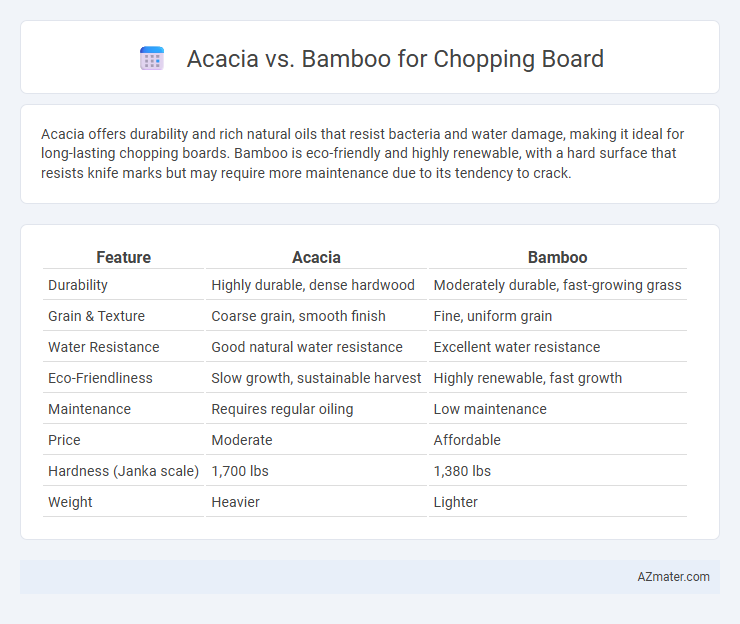Acacia offers durability and rich natural oils that resist bacteria and water damage, making it ideal for long-lasting chopping boards. Bamboo is eco-friendly and highly renewable, with a hard surface that resists knife marks but may require more maintenance due to its tendency to crack.
Table of Comparison
| Feature | Acacia | Bamboo |
|---|---|---|
| Durability | Highly durable, dense hardwood | Moderately durable, fast-growing grass |
| Grain & Texture | Coarse grain, smooth finish | Fine, uniform grain |
| Water Resistance | Good natural water resistance | Excellent water resistance |
| Eco-Friendliness | Slow growth, sustainable harvest | Highly renewable, fast growth |
| Maintenance | Requires regular oiling | Low maintenance |
| Price | Moderate | Affordable |
| Hardness (Janka scale) | 1,700 lbs | 1,380 lbs |
| Weight | Heavier | Lighter |
Introduction to Acacia and Bamboo Chopping Boards
Acacia wood chopping boards are known for their durability, natural antibacterial properties, and rich, dark grain patterns that enhance kitchen aesthetics. Bamboo chopping boards offer a sustainable option, characterized by their lightweight structure, high hardness, and resistance to knife scarring. Both materials provide eco-friendly alternatives to plastic, with Acacia favored for moisture resistance and Bamboo prized for rapid renewability and hardness.
Material Composition: Acacia vs Bamboo
Acacia chopping boards are made from hardwood known for its density and natural resistance to knife marks and moisture, featuring rich, dark grain patterns that add aesthetic appeal. Bamboo boards, composed of fast-growing grass fibers compressed into hard layers, offer a lightweight yet durable surface that is less porous than traditional hardwoods, promoting hygiene and reducing warping. Both materials are sustainable options, but acacia's harder texture provides greater durability while bamboo's natural antimicrobial properties make it ideal for frequent kitchen use.
Durability and Strength Comparison
Acacia wood offers exceptional durability due to its high density and natural resistance to moisture and scratches, making it ideal for long-lasting chopping boards. Bamboo, while technically a grass, is known for its rapid growth and sustainability but tends to be harder and more brittle, which can cause it to chip or crack under heavy chopping. Overall, acacia boards provide superior strength and longevity, whereas bamboo boards excel in eco-friendliness but may require more careful maintenance to avoid damage.
Water Resistance and Maintenance Needs
Acacia chopping boards exhibit moderate water resistance due to their dense, natural oils, requiring regular oiling to maintain durability and prevent cracking. Bamboo boards offer superior water resistance as bamboo fibers are tightly packed and naturally resistant to moisture absorption, reducing the risk of warping and bacterial growth. Maintenance for acacia involves more frequent conditioning, while bamboo demands less upkeep, making it a low-maintenance choice for regular kitchen use.
Knife-Friendliness and Surface Texture
Acacia chopping boards are known for their dense, tight grain, which offers a durable and moderately knife-friendly surface that minimizes blade dulling. Bamboo boards feature a harder, more fibrous texture that resists water absorption but can be tougher on knives, leading to quicker blade wear over time. Choosing between acacia and bamboo depends on balancing durability with maintaining sharp knife edges, with acacia generally preferred for better knife-friendliness and a smoother cutting surface.
Environmental Impact and Sustainability
Acacia chopping boards are derived from a fast-growing hardwood that is both durable and sustainable, often sourced from managed plantations which help reduce deforestation. Bamboo, being a grass, regenerates rapidly without the need for replanting, making it one of the most eco-friendly materials with a lower carbon footprint and high renewability. Both materials are biodegradable and less resource-intensive compared to plastic alternatives, but bamboo's quicker growth cycle and minimal pesticide requirements give it a significant edge in environmental sustainability.
Visual Appeal and Aesthetic Differences
Acacia chopping boards feature a rich, warm tone with intricate grain patterns that create a natural and rustic look, enhancing kitchen aesthetics. Bamboo boards display a lighter, uniform color and a sleek, minimalist appearance, offering a modern and clean visual appeal. The choice between acacia and bamboo influences the overall kitchen style, with acacia complementing traditional or farmhouse designs and bamboo fitting contemporary or eco-conscious decors.
Price Comparison: Acacia vs Bamboo Boards
Acacia chopping boards generally cost more than bamboo boards due to their dense hardwood composition and unique grain patterns. Bamboo boards are typically more affordable, offering a lightweight and eco-friendly option with rapid renewability. Price variations also depend on board size, thickness, and brand reputation, with bamboo often favored for budget-conscious buyers.
Common Uses and Best Applications
Acacia and bamboo are popular choices for chopping boards due to their durability and natural antimicrobial properties. Acacia, known for its rich hardness and resistance to water, is ideal for heavy-duty chopping and cutting tasks, making it suitable for both home kitchens and professional use. Bamboo, being lightweight and eco-friendly, excels in everyday food preparation and slicing softer ingredients, providing a sustainable option for environmentally conscious users.
Final Verdict: Which Chopping Board to Choose?
Acacia chopping boards offer superior durability and resistance to bacteria due to their dense hardwood structure, making them ideal for long-term kitchen use. Bamboo boards are eco-friendly and naturally antimicrobial while being lightweight and budget-friendly, but they may wear down faster with heavy chopping. For a balance of longevity and hygiene, acacia is the preferred choice, while bamboo suits those seeking sustainability and affordability.

Infographic: Acacia vs Bamboo for Chopping Board
 azmater.com
azmater.com